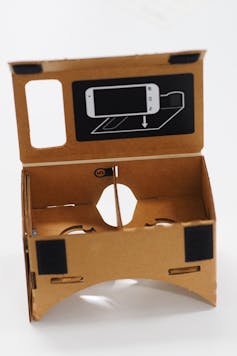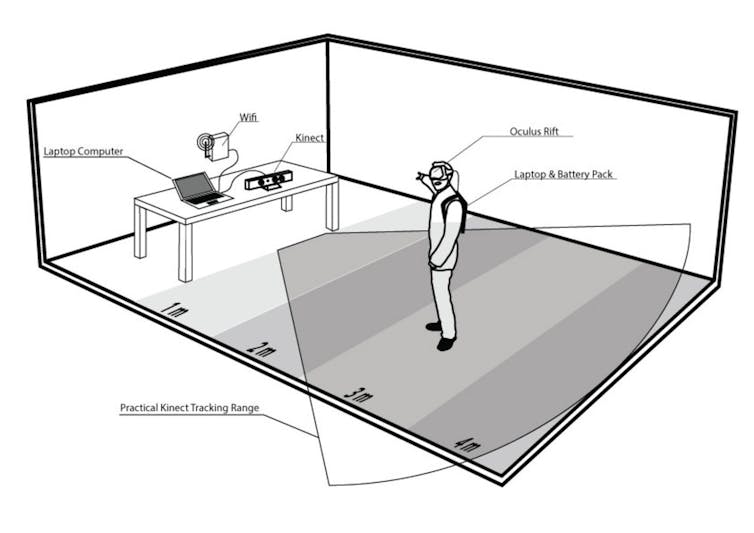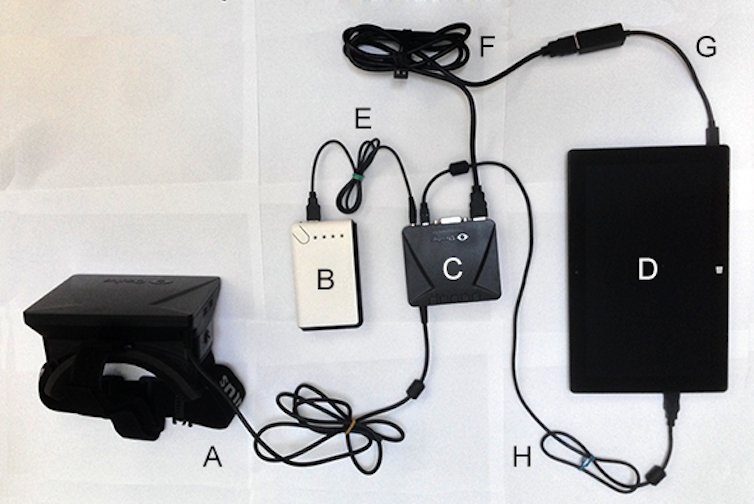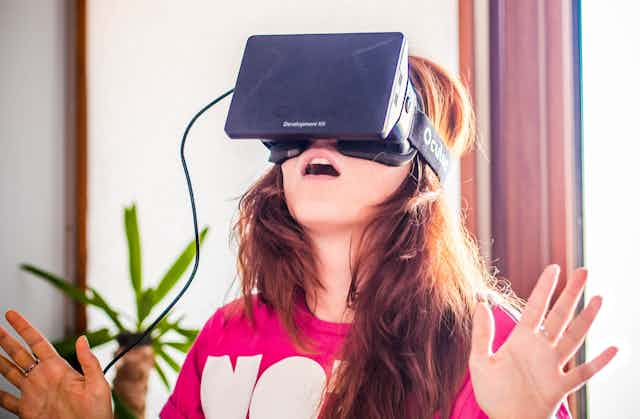Virtual reality is no longer the expensive, cumbersome exercise it once was. Google Cardboard, launched at last week’s Google I/O conference, is a no-frills, cardboard frame that, when used with open software, transforms a smartphone into a basic virtual reality headset.
But for a more immersive experience, hobbyists can build their own virtual reality system in their living room using equipment they already have (and if not, can buy relatively inexpensively).
All you need to beam yourself onto the bridge of the USS Enterprise or into Jerry Seinfeld’s apartment is:
- a computer
- an Oculus Rift virtual reality headset
- a Microsoft Kinect for Windows motion sensor
- a battery
- headphones
- a tablet with software used to create and develop videogames (also know as a game engine).
A stroll through virtual reality history
The term “virtual reality” was initially coined by American computer scientist Jaron Lanier in 1989 to describe a three-dimensional, computer-generated environment which a person can explore and interact with.
Virtual reality quickly attracted media attention and inspired films such as the The Lawnmower Man in 1992 and Disclosure in 1994 – but this fuelled expectations of virtual reality that couldn’t be met by the technology available at the time.
Virtual reality gaming interfaces such as the Virtuality HMD headset in 1991, Cybermaxx VR in 1994 and Nintendo’s Virtual Boy in 1995 left many enthusiasts of the technology disappointed, and often quite dizzy.
Systems that enable users to walk and interact in the space are generally expensive (to the tune of hundreds of thousands of dollars), unsuited to routine use and obtrusive, so it’s unsurprising that virtual reality has mostly remained in the laboratory.
Virtual roaming at home
To make virtual reality practical for home use, you need a system that is inexpensive, easy to set up, does not encumber the user and works in a lounge room-sized area.
The availability of head-mounted displays such as the Oculus Rift, motion tracking devices such as the Microsoft Kinect and game engines such as Unity 3D or UDK are a step into the right direction.

The Kickstarter success of the Oculus Rift in 2012 reinvigorated the appetite for virtual reality experiences and paved the way for new wave of virtual reality head-mounted displays such as the Sony Morpheus and the Google Cardboard.
The Nintendo Wii and the Microsoft Kinect have already started a revolution in home gaming by getting the gamer out of the chair. The Kinect tracks the user’s movement in the living room in seconds without the need for special markers or lengthy calibration.
Ultra-light tablet computers are also becoming more powerful and are now capable to render convincing three dimensional environments at acceptable frame rates.
OK, I’ve got the goods. Now what?
SpaceWalk is a platform developed by researchers in the GEELab at RMIT University that allows a user to physically walk around and interact in a virtual environment. The platform uses two systems:
- a virtual reality backpack
- a separate tracking station.
The tracking station consists of a standard desktop computer connected to Kinect. The Kinect has a practical tracking area of approximately 6m2, about the size of most people’s living rooms. It can track movements as little as 1.3mm when users are close to the sensor and 6mm at the end of its tracking range.

The user’s backpack contains an external phone charger battery pack [B] connected to the Oculus Rift controller box [C] via a USB to DC Barrel Jack [E] and provides the Oculus Rift [A] with power. The Oculus Rift connects via HDMI [G] to the tablet computer [D].

The platform is only meant at this point to serve as an experimental setup and users have to move slowly in the space as particularly fast movements have the potential to induce nausea. Frame rates, screen resolutions, tracking accuracy and latency are expected to improve with the availability of new hardware.
The Oculus Developer’s Kit 2 already promises refresh rates of up to 75Hz and a third higher screen resolution of 960 x 1080 pixels per eye. Similarly, the Kinect 2 for Windows features more accurate user tracking and a larger practical tracking area.
Moving and interacting naturally in virtual reality creates an extraordinary sense of immersion that cannot be experienced sitting down, and the experience of walking and interacting in a virtual game space has been explored by number of recent projects.
Apart from Architectural Visualisation and Industrial Training, defending yourself against a horde of zombies is a popular use case that has been explored by Project Holodeck and ZeroLatency.
On a similar vein, participants could experience vertigo using a setup developed by Inition at the 2013 Digital Shoreditch Festival.
If encountering your worst nightmare within the confines of a few square metres is not enough, users can explore the vast expanse of their virtual world on foot with an omni-directional treadmill.
To understand how virtual reality can be become a useful extension of our real world, the technology must break the boundaries of the dedicated virtual reality laboratory and become accessible by a wider user group with a variety of backgrounds and motivations.
We have just begun to realise the potential of virtual reality and there are many strange new worlds for us to explore.

